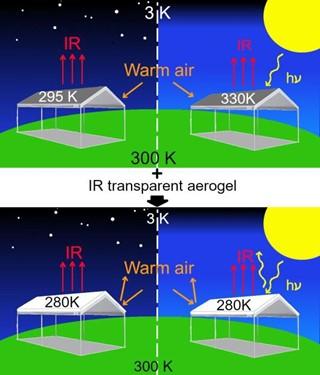Surfaces that face towards the sky experience thermal radiative heat loss. The radiation can then escape to space because the atmosphere is transparent to wavelengths between 8 and 13 um which encompasses the peak of thermal radiation at room temperature. By using passive cooling materials, the underlying sky-facing surface can be cooled to sub-ambient temperatures. One promising material is aerogel made of polyethylene (PE). However, the polymeric material easily degrades in sunlight and is expensive. When PE aerogels are used, the IR transmission is subsequently reduced within just a few days and the PE films only last weeks to months before falling apart.
LLNL researchers have developed an approach to efficient cool surfaces by designing an inexpensive material/device combination which allows for heat loss into space and prevents heating from sunlight and ambient surroundings.
LLNL researchers have developed a passive cooling system which is (1) infrared transparent in the 8-13 um wavelength range, (2) optically reflective to reduce surface heating from sunlight, and (3) thermally insulating to avoid heating from surrounding air. The device uses a material composite that provides cooling via maintaining a temperature difference between a surface and ambient air. The LLNL technology consists of:
- A foam or aerogel
- made from an inexpensive IR transparent material, such as common table salt (NaCl)
- contains a certain size distribution and porosity to add optical reflectance and maintain strength, while continuing to provide high thermal resistance for insulating power.
- that can be coated with a hydrophobic coating to stop moisture absorption and other deleterious effects of outdoor weather
- An optomechanical frame that serves
- to concentrate emitted radiation to the most transparent part sky (near vertical) and improve the net cooling power
- as a mechanical support to the foam.
- A UV-stabilized, IR transparent plastic film can encapsulate the whole device as a moisture and water barrier.
Image Caption: IR transparent composite foam covering a roof’s surface allow for passive cooling at night as well as daytime
M. D. Batista, A. L. Troksa, H.V. Eshelman, M. Bagge-Hansen, J. D. Roehling “All-day passive radiative cooling using common salts.”, Mater. Horiz., 2023, Advance Article (https://doi.org/10.1039/D3MH01139A)
- Can be used to cool virtually any surface.
- Uses low cost, earth abundant materials, such as NaCl.
- Flexible design architecture for the optomechanical frame, which can be customized; modules can be tailored for targeted use cases.
Can be used for:
- Cooling buildings or vehicles directly
- Recycle evaporated process water (cooling towers) and condense potable water from the air in arid areas
- Electricity-free air conditioning, remote refrigeration, potable water
Current stage of technology development: TRL 4
LLNL has patent protection and copyrights on this invention.
U.S. Patent Application No. 2023/0106815 Infrared Transparent Foam Composite For Deep Subambient Cooling Of Virtually Any Surface published 4/6/2023


